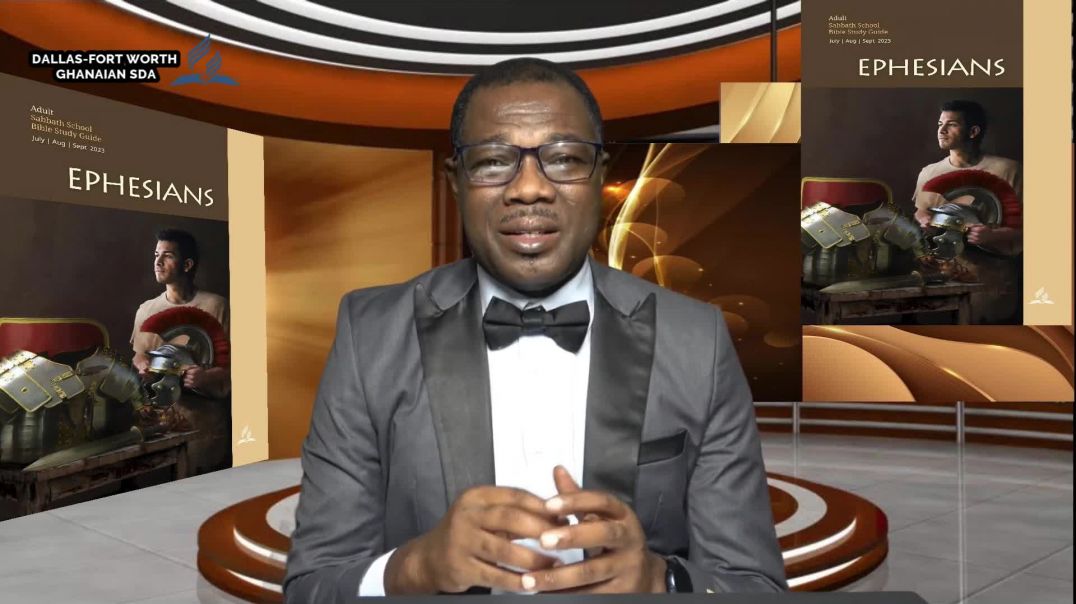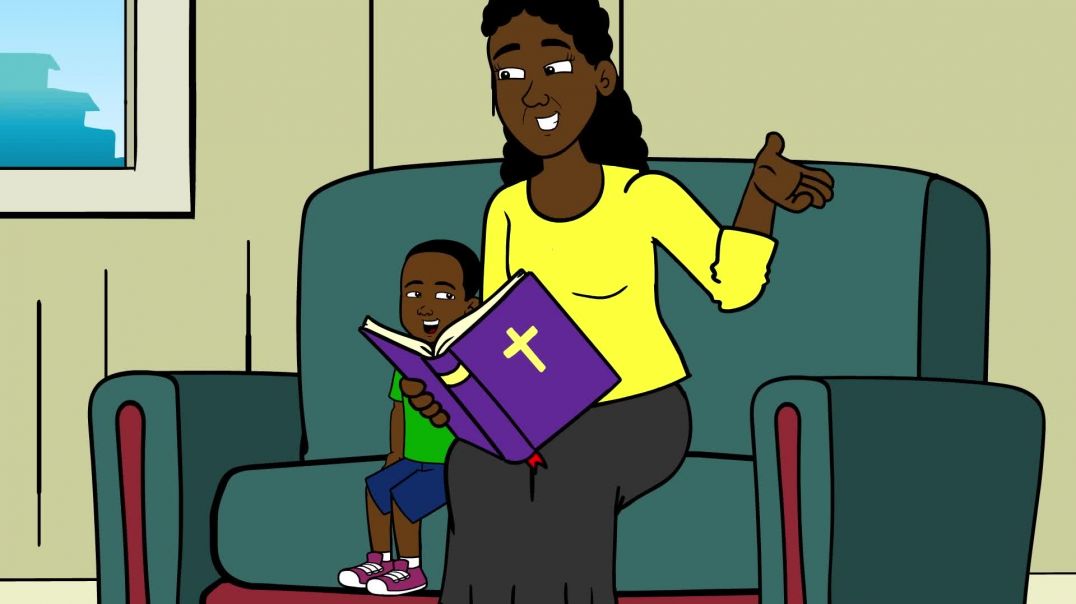Sabbath Afternoon
Read for This Week’s Study: Eph. 5:21–33; Phil. 2:3, 4;
Ezek. 16:1–14; 2 Cor. 11:1–4; Gen. 2:15–25.
Memory Text: “Husbands, love your wives, just as Christ also loved
the church and gave Himself for her, that He might sanctify and cleanse
her with the washing of water by the word, that He might present her to
Himself a glorious church, not having spot or wrinkle or any such thing,
but that she should be holy and without blemish” (Ephesians 5:25–27,
NKJV).
I
n Ephesians 5:21–33, Paul builds on the idea of the submission of
believers to each other (Eph. 5:21); he then offers counsel to Christian
wives (Eph. 5:22–24) and husbands (Eph. 5:25–32); and he concludes
with a distillation of the instruction to both (Eph. 5:33).
In this counsel, Bible students today may hear the risen Christ addressing
our relationships. We are positioned to do so when we understand Ephesians
5:21–6:9 as Paul’s way of actualizing the great theme of the letter, unity, but
now for the Christian household. While he offers a strong critique of the
flawed social structures of the old humanity (see Eph. 4:22), he also celebrates
the creation of a new humanity (see Eph. 2:15) embedded within the wider
humanity with its flawed social structures. From within these structures,
believers demonstrate that a new power, the Holy Spirit (Eph. 2:22; Eph. 3:16;
Eph. 5:18–21; Eph. 6:17, 18) and a new ethic patterned on Christ (Eph. 4:13,
15, 20–24, 32; Eph. 5:2, 10, 17, 21–33) have been unleashed, which point
toward the ultimate fulfillment of God’s plan for His people and the world.
* Study this week’s lesson to prepare for Sabbath, September 2.
Lesson *August 26–September 1
81
August 27
Counsel to Christian Wives
Paul begins with a hinge passage (Ephesians 5:21) connecting
Ephesians 5:1–20 and Ephesians 5:22–33, in which he advocates for
church members to submit to each other (compare Mark 10:42–45;
Rom. 12:10; Phil. 2:3, 4). Believers are to do so “out of reverence for
Christ” (Eph. 5:21, ESV), the first of several times Paul will identify
the relationship with Christ as the most important and defining one for
believers.
What does Paul mean by exhorting church members to submit to each
other? How are we to understand this idea? Eph. 5:21.
________________________________________________________
________________________________________________________
Paul also invites Christian wives to submit to “your own husbands, as
to the Lord” (Eph. 5:22, ESV), clarifying that he is discussing the submission of wives to their respective husbands (see also 1 Pet. 3:1, 5).
When Paul says wives are to do so “as to the Lord,” does he mean a wife
is to submit to her husband as though he were Christ; or, instead, does
He mean that Christ is the truest and highest focus of her submission?
In view of Ephesians 6:7, where slaves are asked to serve “as to the
Lord, and not to men” (NKJV), and Colossians 3:18, where wives are
asked to submit to their husbands “as is fitting in the Lord” (NKJV),
the latter view is to be preferred. Wives are themselves believers who
must ultimately honor Christ over their husbands.
In both Colossians and Ephesians, Christ—and only Christ—is
identified as the Head of the church, which is His body (Eph. 1:22,
Eph. 5:23, Col. 1:18): “Christ is the head of the church; and He is the
Savior of the body” (Eph. 5:23, NKJV). By analogy, the husband is “the
head of the wife” (Eph. 5:23), with the church’s faithfulness to Christ
serving as a model for the wife’s loyalty to her husband. The passage
presumes a loving, caring marriage, and not a dysfunctional one. This
verse should not be interpreted to allow any form of domestic abuse.
In light of what we have just read, why is this following counsel
so important to remember? If the husband “is a coarse, rough,
boisterous, egotistical, harsh, and overbearing man, let him never
utter the word that the husband is the head of the wife, and that
she must submit to him in everything; for he is not the Lord, he
is not the husband in the true significance of the term.”—Ellen
G. White, The Adventist Home, p. 117.
______________________________________________________
Sunday
82
August 28
The Church as the Bride of Christ: Part 1
Compare Ephesians 5:25–27, 29 with the foundling story of Ezekiel
16:1–14. What elements of that story does Paul reflect in his own
sketch?
________________________________________________________
________________________________________________________
As Paul, in Ephesians 5:25–27, 29, shapes his wedding-marriage
metaphor for the church and its relationship with Christ, he draws creatively on the customs and roles of an ancient wedding. In relationship to
the church as bride, Christ is the divine Bridegroom who:
(1) Loves the church as bride (Eph. 5:25). We must never forget that
this is heart work for Jesus. He loves us!
(2) Gives Himself as the bride price. In the context of ancient
wedding arrangements, the bridegroom would “purchase” the bride
with the “bride price,” which was usually a large sum of money and
valuables, so large that ancient village economies depended upon the
custom. Christ pays the ultimate price for the church as His bride since
He “gave Himself for her” (Eph. 5:25, NKJV). In the incarnation and
at the cross, He gives Himself as the bride price.
(3) Bathes His bride. The preparation of the bride was an important
part of the ancient wedding festivities. As is also true today, it was the
bridesmaids and female relatives of the bride who prepared her for the
ceremony. Paul, though, imagines the divine Bridegroom preparing His
bride for the wedding! It is He who sanctifies and cleanses her “by the
washing of water” (Eph. 5:26, ESV), a probable reference to baptism.
(4) Speaks the word of promise. This cleansing is performed “with
the word” (Eph. 5:26, ESV), pointing to the word of promise that the
divine Bridegroom speaks to His bride, perhaps in the context of the
betrothal ceremony (compare Eph. 1:3–14, Eph. 2:1–10, noting God’s
promises to believers at the time of their conversion). Betrothal was the
ancient version of modern engagement, but was a much more serious
set of negotiations, which included a written agreement about the bride
price (from the husband) and the dowry (assets the bride would bring
to the marriage from her family).
(5) Prepares and adorns the bride. When the bride is finally presented to
her Groom, she is fabulously beautiful, appearing in flawless splendor (Eph.
5:27). Christ not only bathes the bride; He prepares and adorns her, as well.
How do these verses help us understand the way Christ feels
about us? Why should we find this so comforting?
______________________________________________________
Monday
83
The Church as the Bride of Christ: Part 2
How does Paul use elements of the ancient wedding in appealing to
Christians in Corinth? When does the presentation occur? (2 Cor.
11:1–4).
________________________________________________________
________________________________________________________
Using one final element of the ancient wedding, in Ephesians
5:25–27 Paul portrays Christ as the One who: (6) presents the bride (to
Himself!). In ancient times the bride would be given away by the best
man, best men, or her father. Never by her groom! Here, though, Paul
imagines Jesus presenting the church as bride to Himself.
Paul uses marriage customs and roles to highlight Christ’s relationship to the church in an unfolding, chronological pattern: (1) Betrothal.
Christ offered Himself up for the church (as “bride price”) and so
became betrothed to her (Eph. 5:25). (2) Preparation for the wedding
ceremony. The attentions of the Bridegroom continue in His present
efforts to sanctify and cleanse the bride (Eph. 5:26). (3) The wedding
ceremony itself. Christ’s present attentions are in view of the “presentation” of the bride at the wedding (Eph. 5:27). This last element
looks to the grand wedding celebration at His return, when Christ, the
Bridegroom, will come to claim the church as bride and present her to
Himself (Eph. 5:27; compare 2 Cor. 11:1, 2; Col. 1:21–23, 28).
Ancient weddings often began with a nighttime parade (see Matt.
25:1–13). The groom and his entourage would gather at the groom’s
home—the couple’s new home—and with grand ceremony begin a
procession. Lit by torches and accompanied by joyful, lilting music
and great rejoicing, the crowd jostles toward the home of the father of
the bride. Gathering up the bride there or meeting the bride’s own procession on the way, the parade would convey the couple to their new
home, where the guests would settle into a weeklong feast, culminating in the wedding ceremony, when the bride would be presented to
the groom.
When Paul portrays Christ presenting the church to Himself, he
alludes to this grand parade and to the moment of presentation. In
doing so, he provides a moving portrait of Christ’s return as a future
wedding ceremony, when the long betrothal between Christ and His
church is complete and the wedding celebrated.
What message should we take for ourselves from all this positive,
happy, and hopeful imagery?
______________________________________________________
Tuesday August 29
84
August 30
Love Your Wife as You Do Yourself
What new argument does Paul use to encourage husbands to practice
tender love toward their wives? Eph. 5:28–30.
________________________________________________________
________________________________________________________
Paul’s rules for the Christian household (Eph. 5:21–6:9) disclose
a challenging social context. In Ephesians 5:28–30, Paul addresses
husbands who, following the all-too-frequent pattern of the time, may
choose to “hate their own flesh” (see Eph. 5:28, 29), abusing and
beating their wives. In the Greco-Roman world of Paul’s day, the legal
power of the “father of the family” (Latin, pater familias) was very
broad. He could punish harshly or even kill his wife, children, and
slaves and be within his legal rights (though exercising such power in
extreme ways was increasingly constrained by public opinion).
In Ephesians 5:25–27, Paul has detailed the ultimate example of
love, Christ’s love for the church, offering a drastically different
model for husbands than the usual one. Now, before laying out a new
argument, he points again to that great Example, asking Christian
husbands to respond “in the same way” (Eph. 5:28, ESV) as Jesus,
who “gave himself up” for His bride, the church, and attends to her
every need (Eph. 5:25–27, ESV). Paul challenges Christian husbands
to turn from the expected practices of their time and seek to match
Christ’s tender love.
In Ephesians 5:28–30, Paul adds a new rationale to support the love
of Christian husbands for their wives: self-love. Paul offers a truism:
“No one ever hated his own flesh” (at least no one thinking clearly).
Husbands don’t harm themselves or beat up on their own bodies.
Instead, they “nourish and cherish” them (Eph. 5:29, NKJV). In a bid to
eliminate harshness and violence against Christian wives, Paul invites
the Christian husband to identify with his wife. You are so much one
with your wife, Paul argues, that to harm her is nothing short of inflicting self-harm, and most people in their right minds don’t do that.
Returning to the example of Jesus, Paul argues that Christ is Himself
practicing tender self-care in cherishing believers who are “his body” (Eph.
5:29, 30, ESV). Model your behavior toward your wife, says Paul, on the
way you treat yourself and, ultimately, on the way Christ treats you.
Paul cites the example of Jesus to both wives and husbands. What
can you learn from Jesus about loving those in your own family
circle?
______________________________________________________
Wednesday
85
The “One Flesh” Model of Marriage
Study the Creation narrative of Genesis 2:15–25. What happens in the
story before the statement concerning a husband and wife being
“one flesh” (Gen. 2:24)?
________________________________________________________
________________________________________________________
A key to applying Paul’s counsel to wives and husbands is to see his
citation of Genesis 2:24 (in Ephesians 5:31) as the culmination of it.
As he meditates on the Creation story of Genesis, Paul considers the
needs of Christian congregations and the health of family relationships
within them. He hears in Genesis 2:24 a message that echoes down
through time. By divine design, marriage is intended to be a “one flesh”
relationship, with sexual unity mirrored in emotional and spiritual
unity, and emotional and spiritual unity bringing meaning to the sexual
relationship.
Note that in choosing Genesis 2:24, Paul selects a statement about
marriage made before the Fall and applies it to the relationships
between Christian husbands and wives. In our distinctly post-Fall
world, rampant exploitation of the sexual relationship between a man
and a woman reveals how deeply entrenched in modern cultures is the
idea that the sexual union represents subjugation of the woman. Paul
argues that the sexual relationship, as reflected in Genesis, is not one
of subjugation but of union. It does not symbolize or actualize the
dominance of the male but the union of husband and wife, so much so
that they are “one flesh.” We may look to both Ephesians 5:21–33 and
Genesis 2:24, then, for an important, countercultural, and corrective
theology of marriage and sexuality.
In this same context, Paul in the next verse talks about a “profound
mystery” (see Eph. 5:32, ESV). This includes both sides of the double
metaphor Paul has been discussing: Christian marriage understood
in the light of Christ’s relationship with His church (Eph. 5:32)
and Christ’s relationship with His church understood in the light of
Christian marriage (Eph. 5:32).
Christian marriage is elevated by comparing it to the relationship between Christ and the church. In addition, by thinking of the
church’s relationship to Christ through the lens of a caring, Christian
marriage, believers gain new clarity about their shared relationship
to Christ.
In what ways does Ephesians 5:33 serve as a concise summary
of Paul’s counsel in Ephesians 5:21–32? If married, how can you
seek to more fully implement these principles in your marriage?
Thursday August 31
86
September 1
Further Thought: Ellen G. White, “Responsibilities of Married Life,”
Testimonies for the Church, vol. 7, pp. 45–50, and “Mutual Obligations,”
The Adventist Home, pp. 114–120.
Ellen G. White consistently urges marriage partners to turn away
from efforts to control the other: “Do not try to compel each other to
yield to your wishes. You cannot do this and retain each other’s love.
Be kind, patient, and forbearing, considerate, and courteous.”—The
Adventist Home, p. 118.
She comments directly on the interpretation and application of
Colossians 3:18 (and Eph. 5:22–24): “The question is often asked,
‘Shall a wife have no will of her own?’ The Bible plainly states that
the husband is the head of the family. ‘Wives, submit yourselves unto
your own husbands.’ If this injunction ended here, we might say that
the position of the wife is not an enviable one. . . . Many husbands
stop at the words, ‘Wives, submit yourselves,’ but we will read the
conclusion of the same injunction, which is, ‘As it is fit in the Lord’
[Col. 3:18]. God requires that the wife shall keep the fear and glory of
God ever before her. Entire submission is to be made only to the Lord
Jesus Christ, who has purchased her as His own child by the infinite
price of His life. . . . There is One who stands higher than the husband
to the wife; it is her Redeemer, and her submission to her husband is
to be rendered as God has directed—‘as it is fit in the Lord.’ ”—The
Adventist Home, pp. 115, 116.
Discussion Questions:
Ê Imagine someone arguing that Ephesians 5:21–33 is an outmoded passage that no longer addresses Christian relationships
since it enforces a model of marriage focused on the authority and
domination of the husband. How would you respond? What elements from the passage itself would inform your response?
Ë What might Paul’s counsel in Ephesians 5:21–33 have to offer
to those who find themselves in challenging and difficult marriage
relationships?
Ì Some Christians argue that the Creation story in Genesis 1
and 2 is a mere metaphor and that it doesn’t come close to depicting what really happened, which was billions of years of evolution.
What does Paul’s use of the story teach us about how literally he
took it?
Í Dwell more on the theme of “one flesh.” How does this help
us better understand the sanctity of marriage and why married
couples must do everything possible to protect that sanctity?
Friday
Provided by the General Conference Office of Adventist Mission, which uses Sabbath School
mission offerings to spread the gospel worldwide. Read new stories daily at AdventistMission.org. 87
Story inside
Visiting Inmates in Spain
By Gabriel Diaz
Working with inmates is my passion. I have participated in prison ministry
everywhere that I have served as a pastor, first in my homeland of Colombia
and now in Spain.
Over the past two decades, I have visited four prisons in Spain,
including a maximum-security prison for women in the Spanish capital,
Madrid. It took three years of talks with prison officials to gain access to
this prison of 400 women. Prison authorities finally allowed me to enter
the prison for the first time in 2019 and begin leading a worship service
from 5:30 p.m. to 7:00 p.m. every Thursday. Only one woman showed
up for the first worship service. But she was very eager and willing to
listen to me.
“I’m very happy to meet you,” I told the woman. “It fills me with joy to
come here. But we need to pray to meet with even more people.”
We prayed to God to bring more people to our Thursday meetings. When
I arrived at the fourth meeting, 10 women were waiting for me! Today, 60
women attend the meetings every week. They range in age from 22 to about
70. Our worship program is divided into three parts: songs and prayer; a
time for women to share their personal testimonies, called, “Name Your
Miracle”; and Bible study.
When I speak to them, I always remind them that God is their Father in
heaven. “God sees you as His daughters,” I say.
In all my years of serving as a pastor, I have never witnessed worship and
praise like in the prison. The worship and praise are intense. The women are
so sincere and honest in their prayers. Sometimes I long for our Thursday
meetings even more than Sabbath meetings at church.
Our time together is short; so, each woman can write her personal testimony on a piece of paper, bring it to the meeting, and hand it to me at the
end. The letters contain words of praise about how God is changing lives. I
have a high stack of letters now.
A group of church members also visit with the women and give them
Bible studies on weekends. They can only visit with the women behind
glass. They are not allowed inside as I am. But
together we are seeing fruit. Several women have
given their lives to Jesus, and we also have established contact with their relatives.
This mission story illustrates Mission Objective No. 2 of the
Seventh-day Adventist Church’s “I Will Go” strategic plan:
“To strengthen and diversify Adventist outreach . . . among
unreached and under-reached people groups.” For more information, go to the website: IWillGo2020.org.
the church and gave Himself for her, that He might sanctify and cleanse
her with the washing of water by the word, that He might pr..
No comments found








